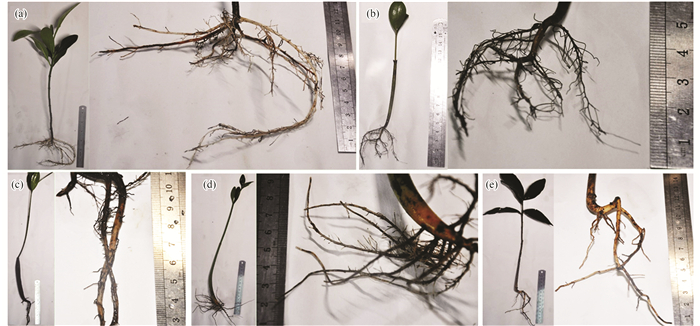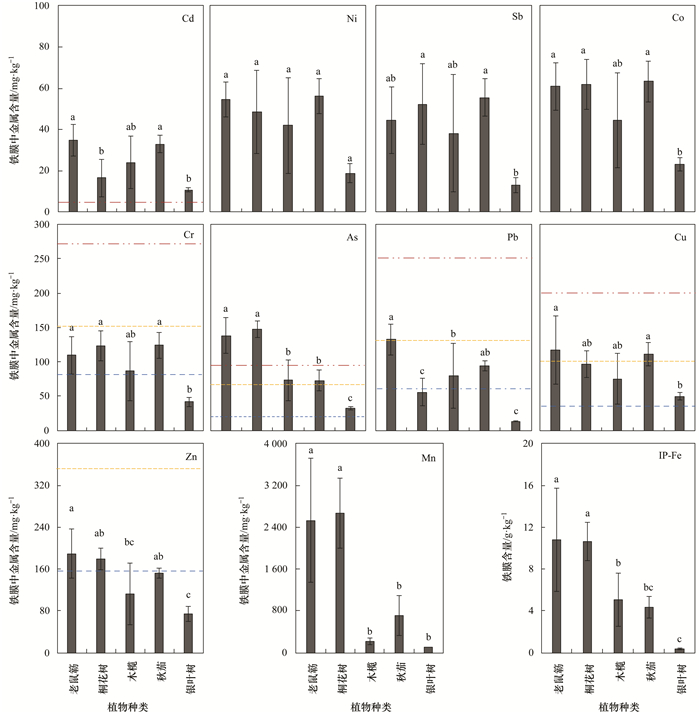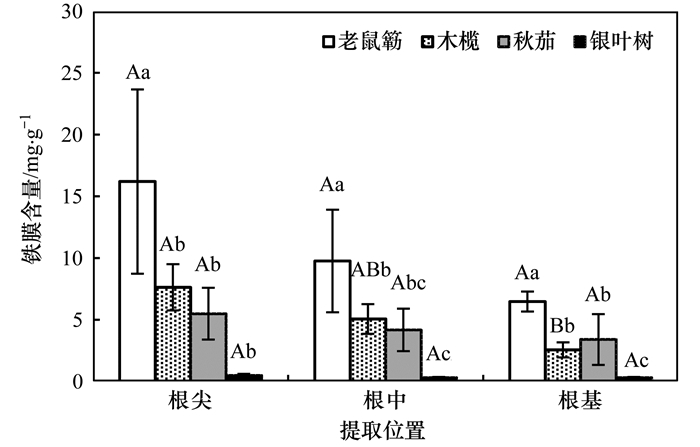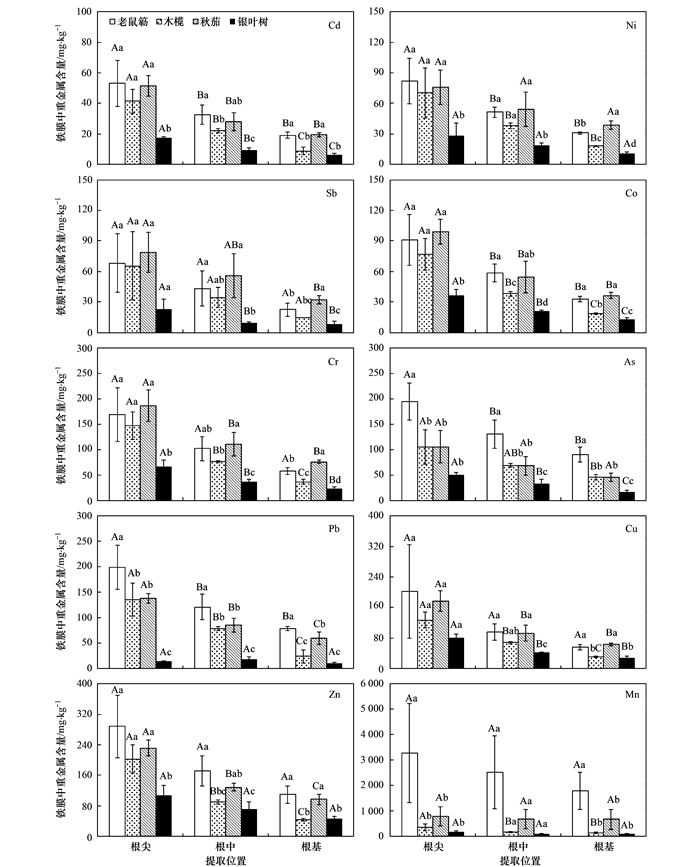植物根表铁膜是一种两性胶体, 可以通过离子之间的吸附-解吸、氧化-还原、有机-无机的络合等作用改变根际环境中重金属的存在形态, 从而影响这些离子的生物有效性, 具有潜在的净化重金属污染的功能[1].根表铁膜在湿地植物根-土界面的研究已经成为湿地环境科学研究中的热点[1~3].现有研究主要涉及根表铁膜的形成条件及影响因素[1, 4~6], 物质组成、形貌与磁性特征[7~9], 对植物营养元素和重金属等污染物吸收的影响及其环境影响因子[1, 10, 11], 铁膜分解过程的元素动态和生态毒理风险[8]等方面.目前, 国内外对根表铁膜的研究主要针对水稻[4, 12, 13]、芦苇[14]和香蒲[15]等草本植物.
湿地植物根表铁膜形成必须具备的两个条件是:植物根际处于局部氧化状态和生长介质中存在充足的Fe2+[2, 16].红树林是分布于热带、亚热带潮间带的木本植物群落.长期的海水浸淹使其沉积物处于还原状态, 红树植物可通过通气组织向地下根系输送氧气, 在根际形成局部氧化环境, 沉积物中还原态的Fe2+被氧化为Fe3+, 在根表形成铁膜[1, 17].植物根表铁膜的数量变异很大, 对环境因子变化响应敏感[18].有研究发现, 红树植物能够通过根系渗氧来改善其对重金属的耐性和修复作用[19].通过城市废水处理能够诱导红树植物产生根表铁膜, 并对净化水质具有一定促进作用[20, 21].然而, 在野外生境中, 红树植物根表铁膜形成有何特点, 对重金属的富集有何影响, 尚未有明确的结论.
深圳湾福田红树林湿地紧邻深圳市中心城区, 长期受人类活动的影响, 成为各种陆源性污染物的“库”, 是研究红树植物根表铁膜及其生态功能的理想研究样地.福田红树林保护区内红树林覆盖面积约111 hm2, 林分按优势树种分秋茄+桐花树林、秋茄林、白骨壤林、秋茄+桐花树+白骨壤林、海桑+无瓣海桑林, 林下普遍生长有老鼠簕, 并有小面积分布的木榄和银叶树.保护区内已对无瓣海桑采取清理措施; 白骨壤受虫害影响, 林下多年未发现幼苗.同时, 木榄林面积逐年增加, 老鼠簕在林下生长繁茂, 银叶树在靠陆端有大量幼苗.综上, 本研究选择深圳湾红树林为研究对象, 旨在阐明:①5种典型红树植物根表铁膜含量及其分布特征; ②红树植物根表铁膜上重金属元素的富集特征; ③沉积物理化性质对红树植物根表铁膜形成及铁膜富集重金属的影响, 以期揭示红树植物根表铁膜在沉积物重金属污染修复中的作用, 并为红树林湿地修复重金属污染的机制研究提供重要的数据支持.
1 材料与方法 1.1 研究区概况和野外采样深圳福田红树林保护区位于深圳湾东北岸, 呈带状分布, 长9 km, 是我国唯一位于城市中心区内的红树林生态湿地. 2017年6月, 在研究区内选择5种典型红树植物的林地:老鼠簕 Acanthus ilicifolius、桐花树 Aeagiceras corniculatum、秋茄 Kandelia obovata、木榄 Bruguiera gymnorrhiza和银叶树 Heritiera littorlis (图 1).在5种林地分别设立3个沿岸分布的5 m×5 m样方, 每个样方随机采集5~6株1龄幼苗; 采集红树植物幼苗后, 将周围沉积物刮去表层腐殖质, 用园艺铲采集.将幼苗和沉积物装入保鲜袋和保鲜箱中运回实验室.将从野外采回的红树植物1龄幼苗, 先用自来水冲洗, 再用去离子水润洗4次, 备用(图 2).沉积物理化性质如表 1所示.

|
●表示采样点:1.银叶树;2.老鼠簕;3.木榄;4.桐花树;5.秋茄 图 1 采样点示意 Fig. 1 Map of the sampling sites |

|
(a)老鼠簕(A. ilicifolius); (b)桐花树(A. corniculatum); (c)木榄(B. gymnorrhiza); (d)秋茄(K. obovata); (e)银叶树(H. littorlis) 图 2 5种典型红树植物幼苗及其根表铁膜 Fig. 2 Five typical species of mangrove seedlings and their root surface iron plaque |
|
|
表 1 沉积物理化性质1) Table 1 Physical and chemical properties of sediments |
1.2 红树植物根表铁膜提取和重金属含量测定
红树植物根表铁膜的提取采用DCB法[22~24].采用火焰原子吸收法(AAS, TAS-990, 普析, 中国)测定提取液中Fe的含量, 回收率为97.73%±7.92%.采用电感耦合光发射光谱仪(ICP-OES, Prodigy XP, Leeman, 美国)测定提取液中Mn、Pb、Zn、Cu、As、Cr、Cd、Ni、Co和Sb元素的含量.将提取过铁膜的根在70℃烘干48 h至恒重.根表铁膜的计算公式为[21, 22]:

|
式中, C1为根表铁膜的含量(mg·g-1); C2为DCB提取液中的铁离子质量(mg); m为DCB提取后根的干重(g); 0.1591为换算系数[20].
1.3 数据处理所测数据以3次重复后的平均值及标准误差(SE)表示, 采用SPSS 20.0软件完成数据处理及统计分析, 采用Excel 2016软件绘图.采用单因素方差分析法(ANOVA, Duncan检验法)进行差异显著性分析(P < 0.05).用Spearman相关分析法分析了根表铁膜与沉积物理化因子以及重金属间的关系.
2 结果与分析 2.1 红树植物根表铁膜及铁膜中重金属的含量5种红树植物根表铁膜及其重金属含量水平可分为3类(图 3):①Fe和Mn含量在1 g·kg-1数量级, 分别为0.37~10.81 g·kg-1和0.11~2.53 g·kg-1.老鼠簕和桐花树根表铁膜含量(IP-Fe)和铁膜中Mn含量显著高于其他红树植物(P < 0.05). ②Pb、Zn、Cu、As和Cr含量基本为100 mg·kg-1数量级.其中, 老鼠簕根表铁膜中的金属含量显著高于银叶树(P < 0.05). ③ Cd、Ni、Co、Sb含量低于100 mg·kg-1.其中, 老鼠簕和秋茄根表铁膜中Cd和Co含量显著高于银叶树(P < 0.05);桐花树和秋茄根表铁膜的Sb含量显著高于银叶树(P < 0.05); Ni在5种红树植物根表铁膜中的含量差异不显著(P>0.05).

|
不同小写字母表示不同红树植物间差异显著(P < 0.05);图中蓝线、黄线和红线分别表示一类、二类和三类海洋沉积物质量标准(GB 18688-2002) 图 3 5种典型红树植物根表铁膜及其重金属含量特征 Fig. 3 Concentrations of root surface iron plaques and their heavy metal contents in five typical species of mangrove seedlings |
红树植物根表铁膜含量与其它重金属呈现极显著正相关关系(P < 0.001, 表 2), 与Zn呈极显著负相关关系(P < 0.001, 表 2).铁膜中Zn的含量与其它金属含量间均呈极显著负相关(P < 0.001, 表 2).沉积物含水量和盐度与铁膜中重金属Cr和Co含量呈正相关(P < 0.05, 表 3), 根表铁膜含量及Mn含量与沉积物pH呈显著负相关(P < 0.05, 表 3); 各(类)金属含量与沉积物TC间无显著相关关系(表 3).
|
|
表 2 根表铁膜与其重金属富集间的关系1) Table 2 Correlation analysis of root surface iron plaques and their heavy metal accumulation |
|
|
表 3 铁膜及其重金属含量与沉积物理化性质间的关系1) Table 3 Relationships between the heavy metal contents in iron plaques and sediment physicochemical properties |
2.2 红树植物根表铁膜及其重金属分布特征
由于桐花树根的生物量较小, 本研究主要分析了老鼠簕、木榄、秋茄和银叶树根的不同部位的铁膜分布特征. 4种红树植物根表铁膜含量变化趋势均为根尖>根中>根基(图 4).其中, 木榄根表不同部位铁膜含量差异显著(F木榄=10.79, P < 0.05), 银叶树、秋茄和老鼠簕不同部位根表铁膜量差异不显著(F银叶树=4.98、F秋茄=0.86和F老鼠簕=2.99, P>0.05).在根尖、根中和根基部位, 老鼠簕的根表铁膜含量均显著高于木榄、秋茄和银叶树(F根尖=8.10、F根中=8.33和F根基=14.85, P < 0.01).

|
不同小写字母表示相同提取位置不同红树植物间根表铁膜含量差异显著, 不同大写字母表示同种植物不同提取位置处根表铁膜含量差异显著(P < 0.05) 图 4 4种红树植物根表铁膜分布特征 Fig. 4 Distributional characteristics of iron plaques on the root surfaces of four species of mangrove seedlings |
10种重金属在4种红树林湿地植物根表铁膜中的分布均表现为:根尖>根中>根基, 与根表铁膜的分布趋势基本一致(除Pb在银叶树根表铁膜中的分布表现为根中居多, 图 5).老鼠簕、木榄和秋茄根尖铁膜中的Cd、Ni、Sb、Co、Cr、Cu和Zn含量显著高于银叶树(P < 0.05);老鼠簕根尖中的As、Pb和Mn含量显著高于其他红树植物(P < 0.05).银叶树根铁膜中的Cd、Ni、Co、Cr、As、Pb、Cu含量显著低于其他红树植物(P < 0.05).银叶树根基铁膜中的Ni、Co、Cr、As含量显著低于其他红树植物(P < 0.05);银叶树和木榄根基铁膜中的Cd、Pb、Cu、Zn含量显著低于老鼠簕和秋茄(P < 0.05).不同植物根表铁膜中同种重金属的含量为:老鼠簕/秋茄>木榄>银叶树(图 5).

|
不同小写字母表示相同提取位置不同植物间(类)金属含量差异显著, 不同大写字母表示同种植物不同提取位置处重金属含量差异显著(P < 0.05) 图 5 4种红树植物根表铁膜中重金属的分布特征 Fig. 5 Distributional characteristics of heavy metals on the root surface iron plaques of four species of mangrove seedlings |
近年来, 对野外生境中湿地植物根表铁膜形成和积累特征的研究, 主要集中于草本湿地植物和水稻等田间作物, 根表铁膜的数量因植物种类和生境差异而变化很大[2, 25, 26].红树植物根表铁膜的研究主要基于控制实验(表 4), 发现红树植物具有较强的形成根表铁膜的潜力[18, 21].因此, 阐明在野外环境中, 红树植物根表铁膜的含量及其分布特征显得十分迫切.本研究选择受人类活动影响较大的深圳湾红树林, 调查了5种典型红树植物根表铁膜的含量, 依次为老鼠簕/桐花树>木榄>秋茄>银叶树(图 3和表 4).其中, 老鼠簕和木榄根表铁膜的含量介于Pi等[21]曝污盆栽实验的研究结果之间; 桐花树、秋茄和银叶树根表铁膜含量均低于Cheng等[18]淹水盆栽实验的结果.在控制实验中, 红树植物生成根表铁膜的能力依次为桐花树>秋茄>老鼠簕>银叶树>木榄(表 4).可见, 红树植物根表铁膜含量因生境条件变化明显.与其他淡水湿地草本植物相比, 红树植物的根表铁膜含量较低(表 4).这可能是因为, 一方面相较于受周期性潮水浸淹的红树林, 长期淹水的淡水湿地植物更有利于根表铁膜的形成[18]; 另一方面, 湿地草本植物比红树植物拥有更发达的通气组织和根系渗氧能力[18, 25], 有利于根表铁膜的形成. Cheng等[18]发现红树植物根孔隙度为5.9%±0.3%~25.2%±2.3%, 小于常见湿地草本植物根孔隙度(9%~64%)[25].
|
|
表 4 湿地植物根表铁膜含量及其重金属富集 Table 4 Contents of root surface iron plaques in wetland plants and their heavy metal enrichment |
红树植物根表铁膜重金属来源于受污染的沉积物.基于Pb同位素的研究发现珠江口及邻近海域沉积物Pb主要来源于人类活动[32].黄小平等[33]利用Fe与重金属的相关性, 发现深圳湾沉积物中Pb、Zn和Cu与Fe相关性较差, 说明与人为污染有关; Ni、Co与Fe相关性良好, 说明主要为自然来源.时运红等[34]发现深圳湾沉积物中重金属Cu、Pb、Zn和As的富集因子指数较高, 说明这4种重金属主要来自人类活动; Cd、Cr、Cu、Pb和Zn之间存在明显的相关性, 具有相似污染途径和迁移过程.在深圳湾湾口和湾内的调查对比发现, 沉积物中Cr、Pb、Hg、Cd、Zn和Cu可能主要来自于深圳和香港的工业废水和生活污水, 而As与深圳湾内煤炭的运输相关[35].王冠森等[36]的研究也发现福田红树林Cd和Zn主要来源于工业废水, Pb主要来源于城市污染排入.综上, 深圳湾福田红树林沉积物重金属污染属于陆源性污染(除As外), 主要通过深圳河、凤塘河和新洲河等引入[37]. Li等[38]的研究表明深圳湾红树林湿地沉积物中Cd含量多介于海洋沉积物质量标准的二类和三类[39]之间; Cu、Cr和Pb含量多介于一类和二类之间; Zn含量多介于二类和三类之间.本研究中, 5种红树植物根表铁膜中Cd含量均劣于三类; 除银叶树铁膜中Cr和Pb含量优于一类标准、Cu含量介于一类和二类标准之间外, 其它4种红树植物铁膜Pb、Cr和Cu含量介于二类和三类之间, Pb部分超过三类标准(老鼠簕和/或桐花树); 5种红树植物铁膜中Zn含量介于一类和二类之间, 甚至优于一类(银叶树) (图 3).可见, 红树植物根表铁膜中重金属含量高于沉积物(除Zn外); 同时, 铁膜中其它重金属含量与铁膜含量呈极显著正相关(除Zn外, 表 2), 这与其他同类研究结果一致[40, 41].说明红树植物根表铁膜对重金属具有一定的富集能力(除Zn外).此外, 张西科等[42]发现水稻铁膜数量越多, 其上Zn的数量也越多; 但Zheng等[43]发现水稻根表铁膜量越多, 其上Zn的含量并未增加, 主要归因于生物炭添加导致的孔隙水中Zn含量的下降.本研究中, 铁膜及其上Zn含量呈显著负相关关系, 而且Zn含量与其它重金属含量间均呈极显著负相关(表 2), 说明Zn可能与其它重金属存在一定竞争关系, 有待进一步研究.
pH主要通过影响铁的有效性而影响根表铁膜的形成.当土壤pH值范围在3~9时, Fe3+的活性随pH增加而降低, 这主要是由于高pH值能够促进形成Fe(OH)3[44].然而, 低pH有利于还原环境中Fe2+的释放, 为根表铁膜形成提供有效态铁离子, 利于根表铁膜形成[45].本研究中, 红树林沉积物偏酸性, 且红树植物根表铁膜含量与pH值呈显著负相关(表 3).说明相比于Fe3+的固定, 红树林湿地中有效态铁离子的供应, 更有利于红树植物根表铁膜的形成.此外, pH值也会影响铁膜中重金属的含量[46]. Batty等[46]的研究表明, 相比于pH=3.5的处理组, pH=6时芦苇根表铁膜富集更多的Mn和Cu.本研究中, 红树植物根表铁膜Mn含量与沉积物pH值呈显著负相关(表 3), 这与铁膜含量与pH的关系一致; 同时, 沉积物pH总体偏酸性且变化较小(5.99±0.25~6.72±0.21, 表 1); 此外, 铁膜及其上Mn含量呈极显著正相关(表 2).因此, 铁膜Mn含量主要受根表铁膜含量影响.有研究发现淹水有利于植物根表铁膜的形成[18, 45].本研究中根表铁膜的形成与沉积物含水量有正相关趋势, 能够促进根表铁膜中重金属的积累.根表铁膜中重金属含量与沉积物盐度呈显著正相关(表 3), 而且沉积物含水量与盐度呈显著正相关, 说明红树林湿地含水量可在一定程度上反映海水浸淹情况, 盐度越高, 受海水浸淹越充分.
本研究中, 4种红树植物根表铁膜总量以及在根中分布均为老鼠簕最高, 木榄和秋茄次之, 银叶树最小(图 4).程皓[19]系统调查过8种红树植物幼苗根的通透性及渗氧情况, 发现红树植物幼苗根部渗氧率为:无瓣海桑、老鼠簕和桐花树(前滩)>红海榄、秋茄和木榄(中滩)>银叶树和杨叶肖槿(后滩), 说明根部渗氧率越高, 铁膜形成量越多. Wang等[47]发现芦苇越接近根基部铁膜数量越多; 而Liu等[48]发现, 在水稻根表铁膜在根尖处含量最高, 根基处最低, 这与本研究结果一致(图 4), 即根表铁膜分布特征为:根尖>根中>根基.这可能是由于从根尖到根基部, 红树植物幼苗根的渗氧方式均表现为典型的“完全屏障”方式, 即供试植物在基部形成渗氧屏障, 限制了根基部的渗氧, 从而保证了更多的氧在根尖部渗出[19]. Wu等[24]在水稻根表铁膜与ROL关系的研究也发现:水稻根表铁膜在根尖处最多, 并且随着距根尖距离的增加而减小, 与ROL的空间趋势一致.可见, 红树植物根系渗氧会影响根表铁膜形成及其在根表的分布.
4 结论(1) 深圳湾红树林5种典型红树植物根表铁膜含量为:老鼠簕>桐花树>木榄>秋茄>银叶树.
(2) 根表铁膜对沉积物中重金属具有一定的富集作用, 并且因植物种类和重金属种类而异, 根表铁膜含量越高的植物, 其铁膜富集的重金属含量越高; 沉积物中含量越高的重金属, 其在铁膜中的含量也越高, 但铁膜中Zn的积累可能与其它金属元素存在竞争关系.
(3) 沉积物理化性质会影响根表铁膜的含量及其对重金属的富集.其中, 沉积物pH显著影响根表铁膜的含量及其对Mn的积累; 沉积物含水量和盐度与铁膜中重金属Cr和Co含量呈正相关.
(4) 红树植物根表铁膜及其重金属含量的分布特征均为根尖>根中>根基.
| [1] | Khan N, Seshadri B, Bolan N, et al. Root iron plaque on wetland plants as a dynamic pool of nutrients and contaminants[J]. Advances in Agronomy, 2016, 138: 1-96. DOI:10.1016/bs.agron.2016.04.002 |
| [2] |
刘春英, 陈春丽, 弓晓峰, 等. 湿地植物根表铁膜研究进展[J]. 生态学报, 2014, 34(10): 2470-2480. Liu C Y, Chen C L, Gong X F, et al. Progress in research of iron plaque on root surface of wetland plants[J]. Acta Ecologica Sinica, 2014, 34(10): 2470-2480. |
| [3] | Tripathi R D, Tripathi P, Dwivedi S, et al. Roles for root iron plaque in sequestration and uptake of heavy metals and metalloids in aquatic and wetland plants[J]. Metallomics, 2014, 6(10): 1789-1800. DOI:10.1039/C4MT00111G |
| [4] | Wu C, Zou Q, Xue S G, et al. The effect of silicon on iron plaque formation and arsenic accumulation in rice genotypes with different radial oxygen loss (ROL)[J]. Environmental Pollution, 2016, 212: 27-33. DOI:10.1016/j.envpol.2016.01.004 |
| [5] | Syu C H, Lee C H, Jiang P Y, et al. Comparison of As sequestration in iron plaque and uptake by different genotypes of rice plants grown in As-contaminated paddy soils[J]. Plant and Soil, 2014, 374(1-2): 411-422. DOI:10.1007/s11104-013-1893-8 |
| [6] | Seyfferth A L, Webb S M, Andrews J C, et al. Arsenic localization, speciation, and co-occurrence with iron on rice (Oryza sativa L.) roots having variable Fe coatings[J]. Environmental Science & Technology, 2010, 44(21): 8108-8113. |
| [7] |
刘春英. 鄱阳湖湿地植物根表铁膜的形成及对铅的转运机制研究[D]. 南昌: 南昌大学, 2015. 66-74. Liu C Y. Study on the formation of iron plaque on the root surfaces of wetland plants from Poyang Lake and its translocation mechanism on lead[D]. Nanchang: Nanchang University, 2015. 66-74. |
| [8] | Yamaguchi N, Ohkura T, Takahashi Y, et al. Arsenic distribution and speciation near rice roots influenced by iron plaques and redox conditions of the soil matrix[J]. Environmental Science & Technology, 2014, 48(3): 1549-1556. |
| [9] |
刘晋嫣, 张卫国, 董艳, 等. 长江口潮滩芦苇根表铁膜磁性特征及其环境意义[J]. 环境科学学报, 2016, 36(9): 3354-3362. Liu J Y, Zhang W G, Dong Y, et al. Magnetic properties of iron plaque on roots of Phragmites australis in tidal flat of the Yangtze Estuary[J]. Acta Sctentiae Circumstantiae, 2016, 36(9): 3354-3362. |
| [10] |
杨世杰, 唐冰培, 王代长, 等. 硫素对水稻吸收砷的生物有效性及其在土壤中形态影响[J]. 环境科学, 2014, 35(9): 3553-3563. Yang S J, Tang B P, Wang D C, et al. Influence of sulfur on the bioavailability of arsenic uptake by rice (Oryza. sativa L.) and its speciation in soil[J]. Environmental Science, 2014, 35(9): 3553-3563. |
| [11] |
马微, 鲍艳宇. 根表铁氧化物胶膜对水稻吸收诺氟沙星的影响[J]. 环境科学, 2015, 36(6): 2259-2265. Ma W, Bao Y Y. Effect of root iron plaque on norfloxacin uptake by rice[J]. Environmental Science, 2015, 36(6): 2259-2265. |
| [12] | Zhang X K, Zhang F S, Mao D R. Effect of iron plaque outside roots on nutrient uptake by rice (Oryza sativa L.). Zinc uptake by Fe-deficient rice[J]. Plant and Soil, 1998, 202(1): 33-39. DOI:10.1023/A:1004322130940 |
| [13] | Okkenhaug G, Zhu Y G, He J W, et al. Antimony (Sb) and arsenic (As) in Sb mining impacted paddy soil from Xikuangshan, China:differences in mechanisms controlling soil sequestration and uptake in rice[J]. Environmental Science & Technology, 2012, 46(6): 3155-3162. |
| [14] | Batty L C, Baker A J M, Wheeler B D. Aluminium and phosphate uptake by Phragmites australis:the role of Fe, Mn and Al root plaques[J]. Annals of Botany, 2002, 89(4): 443-449. DOI:10.1093/aob/mcf067 |
| [15] | Zhong S Q, Wu Y P, Xu J M. Phosphorus utilization and microbial community in response to lead/iron addition to a waterlogged soil[J]. Journal of Environmental Sciences, 2009, 21(10): 1415-1423. DOI:10.1016/S1001-0742(08)62434-1 |
| [16] |
刘侯俊, 张俊伶, 韩晓日, 等. 根表铁膜对元素吸收的效应及其影响因素[J]. 土壤, 2009, 41(3): 335-343. Liu H J, Zhang J L, Han X R, et al. Influences of iron plaque on element uptake by plants and its affecting factors[J]. Soils, 2009, 41(3): 335-343. |
| [17] | Bravin M N, Travassac F, Le Floch M, et al. Oxygen input controls the spatial and temporal dynamics of arsenic at the surface of a flooded paddy soil and in the rhizosphere of lowland rice (Oryza sativa L.):a microcosm study[J]. Plant and Soil, 2008, 312(1-2): 207-218. DOI:10.1007/s11104-007-9532-x |
| [18] | Cheng H, Wang Y S, Fei J, et al. Differences in root aeration, iron plaque formation and waterlogging tolerance in six mangroves along a continues tidal gradient[J]. Ecotoxicology, 2015, 24(7-8): 1659-1667. DOI:10.1007/s10646-015-1474-0 |
| [19] |
程皓. 红树植物根的通透性、渗氧在其重金属Pb、Zn、Cu耐性和净化效应中的作用及机理[D]. 广州: 中山大学, 2010. 34-64. Cheng H. The role of root permeability and Radial Oxygen Loss (ROL) on tolerance and purification of heavy metals (Pb, Zn, Cu) by mangrove plants[D]. Guangzhou: Sun Yat-Sen University, 2010. 34-64. |
| [20] | Pi N, Tam N F Y, Wong M H. Effects of wastewater discharge on formation of Fe plaque on root surface and radial oxygen loss of mangrove roots[J]. Environmental Pollution, 2010, 158(2): 381-387. DOI:10.1016/j.envpol.2009.09.004 |
| [21] | Pi N, Tam N F Y, Wong M H. Formation of iron plaque on mangrove roots receiving wastewater and its role in immobilization of wastewater-borne pollutants[J]. Marine Pollution Bulletin, 2011, 63(5-12): 402-411. DOI:10.1016/j.marpolbul.2011.05.036 |
| [22] | Taylor G J, Crowder A A. Use of the DCB technique for extraction of hydrous iron oxides from roots of wetland plants[J]. American Journal of Botany, 1983, 70(8): 1254-1257. DOI:10.1002/ajb2.1983.70.issue-8 |
| [23] | Arrivabene H P, Campos C Q, da Costa Souza I, et al. Differential bioaccumulation and translocation patterns in three mangrove plants experimentally exposed to iron. Consequences for environmental sensing[J]. Environmental Pollution, 2016, 215: 302-313. DOI:10.1016/j.envpol.2016.05.019 |
| [24] | Wu C, Ye Z H, Li H, et al. Do radial oxygen loss and external aeration affect iron plaque formation and arsenic accumulation and speciation in rice?[J]. Journal of Experimental Botany, 2012, 63(8): 2961-2970. DOI:10.1093/jxb/ers017 |
| [25] | Li H, Ye Z H, Wei Z J, et al. Root porosity and radial oxygen loss related to arsenic tolerance and uptake in wetland plants[J]. Environmental Pollution, 2011, 159(1): 30-37. DOI:10.1016/j.envpol.2010.09.031 |
| [26] | Pereira E G, Oliva M A, Siqueira-Silva A I, et al. Tropical rice cultivars from lowland and upland cropping systems differ in iron plaque formation[J]. Journal of Plant Nutrition, 2014, 37(9): 1373-1394. DOI:10.1080/01904167.2014.888744 |
| [27] | Hupfer M, Dollan A. Immobilisation of phosphorus by iron-coated roots of submerged macrophytes[J]. Hydrobiologia, 2003, 506(1-3): 635-640. |
| [28] | Crowder A A, Macfie S M. Seasonal deposition of ferric hydroxide plaque on roots of wetland plants[J]. Canadian Journal of Botany, 1986, 64(9): 2120-2124. DOI:10.1139/b86-279 |
| [29] | Hansel C M, La Force M J, Fendorf S, et al. Spatial and temporal association of As and Fe species on aquatic plant roots[J]. Environmental Science & Technology, 2002, 36(9): 1988-1994. |
| [30] | St-Cyr L, Crowder A A. Factors affecting iron plaque on the roots of Phragmites australis (Cav.) Trin. ex Steudel[J]. Plant and Soil, 1989, 116(1): 85-93. DOI:10.1007/BF02327260 |
| [31] | Machado W, Gueiros B B, Lisboa-Filho S D, et al. Trace metals in mangrove seedlings:role of iron plaque formation[J]. Wetlands Ecology and Management, 2005, 13(2): 199-206. DOI:10.1007/s11273-004-9568-0 |
| [32] | Ip C C M, Li X D, Zhang G, et al. Trace metal distribution in sediments of the Pearl River Estuary and the surrounding coastal area, South China[J]. Environmental Pollution, 2007, 147(2): 311-323. DOI:10.1016/j.envpol.2006.06.028 |
| [33] |
黄小平, 李向东, 岳维忠, 等. 深圳湾沉积物中重金属污染累积过程[J]. 环境科学, 2003, 24(4): 144-149. Huang X P, Li X D, Yue W Z, et al. Accumulation of heavy metals in the sediments of Shenzhen Bay, South China[J]. Environmental Science, 2003, 24(4): 144-149. |
| [34] |
时运红, 李明远, 李波, 等. 深圳湾沉积物重金属污染时空分布特征[J]. 海洋环境科学, 2017, 36(2): 186-191, 208. Shi Y H, Li M Y, Li B, et al. Spatial and temporal distribution of heavy metals in the sediment of Shenzhen Bay[J]. Marine Environmental Science, 2017, 36(2): 186-191, 208. |
| [35] |
唐得昊, 刘兴健, 邹欣庆. 海湾表层沉积物重金属污染与潜在生态危害评价—以深圳湾为例[J]. 环境化学, 2014, 33(8): 1294-1300. Tang D H, Liu X J, Zou X Q. Heavy metals pollution and their potential ecological risk assessment in the surface sediment from Shenzhen Bay[J]. Environmental Chemistry, 2014, 33(8): 1294-1300. DOI:10.7524/j.issn.0254-6108.2014.08.002 |
| [36] |
王冠森, 柴民伟, 栾胜基. 深圳典型红树林湿地重金属累积特征比较研究[J]. 生态环境学报, 2017, 26(5): 862-870. Wang G S, Chai M W, Luan S J. A comparative study of heavy metal accumulation characteristics in typical mangrove wetlands of Shenzhen, China[J]. Ecology and Environmental Sciences, 2017, 26(5): 862-870. |
| [37] |
邓利, 张慧敏, 劳大荣, 等. 福田红树林自然保护区沉积物重金属污染现状及生态风险评价[J]. 海洋环境科学, 2014, 33(6): 947-953. Deng L, Zhang H M, Lao D R, et al. Contamination and potential ecological risk assessment of heavy metals in surface sediments of Futian Mangrove Nature Reserve[J]. Marine Environmental Science, 2014, 33(6): 947-953. |
| [38] | Li R Y, Li R L, Chai M W, et al. Heavy metal contamination and ecological risk in Futian mangrove forest sediment in Shenzhen Bay, South China[J]. Marine Pollution Bulletin, 2015, 101(1): 448-456. DOI:10.1016/j.marpolbul.2015.09.048 |
| [39] | GB 18668-2002, 海洋沉积物质量[S]. |
| [40] | Zhong S Q, Shi J C, Xu J M. Influence of iron plaque on accumulation of lead by yellow flag (Iris pseudacorus L.) grown in artificial Pb-contaminated soil[J]. Journal of Soils and Sediments, 2010, 10(5): 964-970. DOI:10.1007/s11368-010-0213-7 |
| [41] |
胡莹, 黄益宗, 黄艳超, 等. 根表铁膜对水稻铅吸收转运的影响[J]. 生态毒理学报, 2014, 9(1): 35-41. Hu Y, Huang Y Z, Huang Y C, et al. Influence of iron plaque on Pb uptake and translocation by rice (Oryza sativa L.)[J]. Asian Journal of Ecotoxicology[J]. Asian Journal of Ecotoxicology, 2014, 9(1): 35-41. DOI:10.7524/AJE.1673-5897.20130107001 |
| [42] |
张西科, 张福锁, 毛达如. 根表铁氧化物胶膜对水稻吸收Zn的影响[J]. 应用生态学报, 1996, 7(3): 262-266. Zhang X K, Zhang F S, Mao D R. Effect of root iron plaque on zinc uptake by rice[J]. Chinese Journal of Applied Ecology, 1996, 7(3): 262-266. |
| [43] | Zheng R L, Cai C, Liang J H, et al. The effects of biochars from rice residue on the formation of iron plaque and the accumulation of Cd, Zn, Pb, As in rice (Oryza sativa L.) seedlings[J]. Chemosphere, 2012, 89(7): 856-862. DOI:10.1016/j.chemosphere.2012.05.008 |
| [44] | Kabata-Pendias A, Pendias H. Trace elements in soil and plants[M]. 3rd ed.. Boca Raton, Florida: CRC Press, 2001: 286-366. |
| [45] | Syu C H, Jiang P Y, Huang H H, et al. Arsenic sequestration in iron plaque and its effect on As uptake by rice plants grown in paddy soils with high contents of As, iron oxides, and organic matter[J]. Soil Science and Plant Nutrition, 2013, 59(3): 463-471. DOI:10.1080/00380768.2013.784950 |
| [46] | Batty L C, Baker A J M, Wheeler B D, et al. The effect of pH and plaque on the uptake of Cu and Mn in Phragmites australis (Cav.) Trin ex. Steudel[J]. Annals of Botany, 2000, 86(3): 647-653. DOI:10.1006/anbo.2000.1191 |
| [47] | Wang T G, Peverly J H. Iron oxidation states on root surfaces of a wetland plant (Phragmites australis)[J]. Soil Science Society of America Journal, 1999, 63(1): 247-252. DOI:10.2136/sssaj1999.03615995006300010036x |
| [48] | Liu W J, Zhu Y G, Hu Y, et al. Arsenic sequestration in iron plaque, its accumulation and speciation in mature rice plants (Oryza sativa L.)[J]. Environmental Science & Technology, 2006, 40(18): 5730-5736. |
 2018, Vol. 39
2018, Vol. 39


